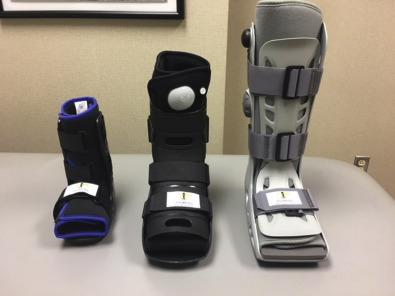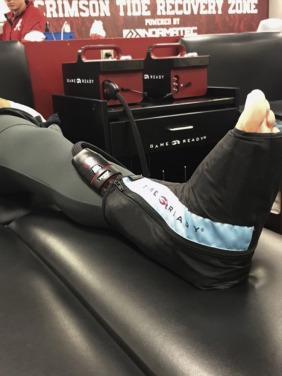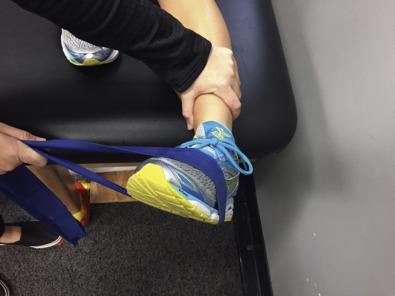Physical Address
304 North Cardinal St.
Dorchester Center, MA 02124
Injuries to the foot and ankle are some of the most common injuries in sport. These injuries can significantly affect the performance of an athlete and can often lead to disability and missed playing time. In a series of over 1600 athletic injuries, Garrick and Requa reported that more than 25% of the injuries occurred in the foot and ankle. More recently, Hunt et al. reported on over 3800 musculoskeletal injuries in NCAA Division 1 athletics. Foot and ankle injuries made up 27% of those injuries, with over one-fifth of those resulting in time loss from sport. The average length of time missed was over 12 days. These injuries are some of the most common injuries leading to time loss in sport. This missed time has led to advances in rehabilitation over the past 20 years aimed at reducing injury time, improving outcomes, and preventing the injuries from becoming chronic.
Athletes provide unique challenges in rehabilitation because of the significant demands required to participate in sports. The foot and ankle are especially vulnerable to these demands. It serves as the connection of the body to the weight-bearing surface. As a result, the foot and ankle are designed to allow efficient energy expenditure in both stance and locomotion. The foot and ankle are a small area of the body with specialized function and intricate muscle, tendon, ligament, and bone interactions designed to meet the strenuous demands of weight bearing and ambulation. Recent technologic and procedural advances contribute greatly to the treatment of the competitive athlete. The principles of rehabilitation must continue to develop with the continuing advances made through improving technologies. An appropriate and advanced rehabilitation can provide the athlete with a full, complete, and functional recovery.
Initial treatment of acute foot and ankle injuries and postoperative pain remains protection, rest, ice, compression, and elevation (PRICE) therapy despite any high-quality evidence that it works better than placebo. Protection involves any intervention aiming to prevent re-injury to the foot and ankle. Rest involves offloading the affected area to decrease the stress on the injured tissues. Ice, compression, and elevation are all methods to control edema and pain.
There are many common devices to aid in the protection of the healing tissues about the foot and ankle. These consist of elastic wrapping, taping/strapping, semi-rigid pneumatic ankle brace, non-rigid functional ankle brace, and the author’s preferred method, a removable walking boot ( Fig. 30.1 ). The device allows patients to weight bear immediately, work on range of motion (ROM) by removing the boot, and use a continuous cold/compression device. Once the ankle has healed, a more functional brace is used for return to activity (2–4 weeks after injury). We particularly stress the use of the boot at night for the first 3 to 4 weeks to keep the foot and ankle complex in a 90-degree dorsiflexion position during sleep, when the relaxation of muscular control and the forces on the heel passively place the complex in a plantar-flexed and inverted position. The rigid boot counteracts this position.

There are several cold agents to choose from, including the reusable cold pack, ice bags, cold whirlpool, ice immersion, and pneumatic cold compressive devices ( Fig. 30.2 ). The primary objective of ice is to reduce swelling and help manage pain. Physiologically, cryotherapy acts through several mechanisms of action. The application of cold agents results in arteriolar vasoconstriction, thus decreasing local metabolism, oxygen utilization, and inflammation. Applying an ice pack to the knee for 20 minutes has been shown to decrease soft tissue blood flow 26% and bone uptake (reflecting changes in blood flow and metabolism) 19%. It has been found that cold therapy increases the pain threshold while decreasing the nerve conduction velocity. Further, as the temperature decreases, there is a corresponding decrease in sensory and motor nerve velocity, eventually causing synaptic transmission to be blocked.

Cryotherapy has been validated as an effective analgesic in many surgical fields including plastic surgery, otolaryngology, obstetrics and gynecology, and maxillofacial surgery. The application of cold is most effective immediately after injury. Hocutt et al. found that patients with grade III ankle sprains that were treated with ice in the first day returned to functional activities such as running and jumping after 6 days, whereas those treated on the second day went 11 days before they could run or jump. In contrast, those who received heat in the first day had a recovery time of 14.8 days. Cote et al. showed that cold therapy alone in the first 3 days after a severe ankle sprain limited the foot and ankle swelling to a 3.3 mL increase in volume versus a 25.3 mL increase seen when heat therapy was used.
In addition to ice therapy, compression devices have been shown to be effective tools for edema control. Myerson et al. showed a 50% reduction in edema in both the acutely swollen and chronically swollen ankle when using an intermittent pneumatic device versus a control device daily for one month. Likewise, Thordarson et al. showed a 60 mL reduction in total foot and ankle volume when using a similar compression device compared to standard splint immobilization prior to surgery for displaced Weber B and C fibula fractures. In our experience, we have found cold compressive devices for the ankle and foot to be most effective, as they combine the positive benefits of cryotherapy and compression simultaneously. These devices work even better when used in conjunction with elevation to reduce hydrostatic pressure and diminish edema.
A contraindication to cryotherapy is individuals with hypersensitivity to cold. Cold should be avoided in patients with Raynaud’s syndrome or peripheral vascular disease. Cold therapy also must be monitored closely in postoperative patients who have wet dressings because the combination of wet dressings with cold application can decrease the skin temperature to a dangerous level. There have been case reports of severe frost-bite occurring due to prolonged cryotherapy.
There has long been a rehabilitation dilemma between the need for early ROM and the need to immobilize tissues to decrease swelling, allow the injured tissues to heal, and protect against pathologic motion. There has been ongoing research across all sections of orthopedics that promote the idea that early mobilization is best for most injuries. For example, early mobilization has been shown to have earlier return to work and better ROM when compared to splint immobilization for simple elbow dislocations. Another randomized controlled trial reported no increased risk of dislocation with improved pain scores, faster return of functional ROM, and increased patient satisfaction with accelerated rehabilitation following arthroscopic Bankart repair of the shoulder.
In 1892, Julius Wolff, a German anatomist, explained that every change in the function of a bone is followed by certain definite changes in internal architecture and external confirmation in accordance with mathematical laws. Stated simply, “form follows function.” Wolff’s law also may apply to these soft tissues, and physiologic stress may allow more functional and stronger healing of soft tissues. Experimental studies of ligaments after injury indicate that exercise and joint motion stimulate healing and influence the strength of ligaments after injury. In addition, it has been shown in animal models that complete removal of load is detrimental to rotator cuff tendon healing, especially when combined with immobilization.
Some of the early research on restoration of early ROM was performed in the hand. These historical papers revealed insight on how early ROM decreases complications and enhances the healing process. Early mobilization may result in an earlier return to work and daily activity, less muscle atrophy, and better mobility compared with immobilization by casting. The value and benefit of early motion was investigated after flexor tendon repairs of the hand. The obvious need for full motion in the hand prompted investigation into safe rehabilitation practices, which would eliminate postoperative adhesions and stiffness but still allow reliable healing of the tendon. Gelberman et al. noted an improved healing response, improved strength, and a more normal pattern of vascularity to the healing tendon with protected early mobilization. Several other studies also noted that early ROM decreased adhesions around the repaired tendon and had a positive influence to the healing tissue. Early motion after flexor tendon repair has become standard today.
Robert Salter and associates investigated the effect of joint motion on cartilage nutrition. They found that early, continuous passive motion in synovial joints promotes cartilage nutrition and health. Salter demonstrated that small cartilage defects could heal with continuous motion, further supporting the benefit of motion on articular cartilage nutrition and healing. Joint motion produces mechanical signals that are perceived by chondrocytes that in turn influence and stabilize the internal cartilage structure and prevent the cartilage thinning seen with prolonged immobilization.
Eiff et al. used a prospective randomized study to determine which treatment for first-time ankle sprains, early mobilization or immobilization, is more effective. They reported that, in first-time lateral ankle sprains, early mobilization allows earlier return to work and may be more comfortable for patients than prolonged immobilization. Both active and passive ROM are utilized to regain motion in cardinal and diagonal planes. Passive ROM allows the muscles to relax while active ROM requires independent muscle action and incorporates muscle re-education. It is important to first work ROM in the direction opposite of the mechanism of injury (i.e., we allow dorsiflexion and eversion and avoid plantarflexion and inversion initially after a grade II or III lateral ankle sprain). Once the injury has healed, ROM should include all directions.
Several recent publications have shown promising clinical results with accelerated rehabilitation protocols. One randomized controlled trial showed that patients undergoing an accelerated rehabilitation protocol after Achilles tendon repair had significantly less tendo-Achilles lengthening and quicker return to full running than patients with traditional immobilization. Another study found that early ROM after anterior talofibular ligament reconstruction for chronic ankle instability led to a 5-week earlier return to full athletic activity when compared to a 4-week period of immobilization with no cases of re-injury or differences in postoperative outcomes. These and other studies have led us to adopt early ROM as a staple in the post-injury and post-surgical management of almost all foot and ankle pathologies.
Early protected weight bearing has been shown in several well-conducted studies to provide excellent clinical outcomes without an increased rate of complications. One randomized controlled trial showed improved patient reported outcomes and ankle ROM with weight bearing begun at 2 weeks postoperatively versus the control group (6 weeks of nonweight bearing, NWB) for operatively treated unstable ankle fractures. Another study found no increased rates of rerupture or other complication with same-day weight bearing versus 4 weeks of NWB for conservatively treated Achilles tendon ruptures.
Recent investigations have published promising results with early weight bearing after procedures that have long been thought to require long periods of NWB. Mann et al. reported a >95% fusion rate in 21 first metatarsophalangeal joint fusions using a titanium plate and full weight bearing at 2 weeks. Another study showed no increased rate of nonunion with early full weight bearing in a multicenter study of 367 patients undergoing a modified Lapidus arthrodesis.
Weightlessness, as seen in space travel, has been shown to have a detrimental effect on muscle. Costill et al. reported that a 17-day space flight resulted in an 11% decrease in peak muscle power, a decrease in muscle fiber diameter, and a 21% decrease in force when the muscle was contracted at peak power velocity. The single fiber muscle diameter decreased 20%. This research helps us understand the atrophy and deconditioning that occurs in our patients when they are made to be NWB for periods much longer than 17 days after certain procedures or injuries.
We favor a postoperative protocol that allows for early weight bearing whenever possible. We recognize there are times when this is not possible, such as comminuted intra-articular fractures. However, in the sports population, early weight bearing can have such a positive impact that we try to tailor our surgical and nonoperative approach to allow early protected weight bearing. Research suggests that early loading of damaged soft tissue can enhance collagen fiber realignment and healing. Using a removable walking boot allows the patient to progress to weight bearing immediately after injury. Being in a walking boot instead of an ankle cast allows the patient to take the boot off to begin rehabilitation activities.
In the instances where immediate weight bearing is not feasible, we are using an antigravity treadmill (AlterG®) to aid in rehabilitation ( Fig. 30.3 ). The antigravity treadmill allows walking and running with significantly reduced weight. This allows the athlete to normalize gait and promote muscle and tendon function while providing the necessary protected weight bearing in some situations.

The evaluation of a patient’s gait immediately after injury and before return to activity can provide a clinician with valuable information on how abnormalities in ambulation contribute to the rehabilitation and prevention of injuries. Often abnormal gait mechanics can predispose the other joints of the lower extremity and back to overload and pain. Restoring normal gait after acute injuries can help to prevent these abnormal mechanics and significantly reduce the amount of time required for return to normal function. It is important that a clinician evaluates the entire lower extremity and its function during gait.
Normal gait is composed of two phases, a stance phase (60%) and a swing phase (40%). The stance phase is composed of five categories, including initial contact (heel strike), loading response (foot flat), midstance (single leg support), terminal stance (heel off), and pre-swing (toe-off). The swing phase consists of initial swing (acceleration), mid-swing, and terminal swing (deceleration).
In acute injuries, a clinician will notice gait abnormalities because of pain, decreased ROM, strength deficits, and lack of proprioception. An antalgic gait is most common, with a decreased stance phase on the affected limb. Crutches can be beneficial for this gait pattern to help the patient remove some percentage of weight/stress on the affected limb and thus allow for a more normal stance phase. A patient may discontinue assistive devices when he or she can walk normally. It is extremely important that as clinicians we correct gait immediately to prevent abnormal gait habits from becoming permanent. It is likely that some failure to return to full strength after a lower-extremity injury is related to adaptive gait changes that become permanent in unloading the injured extremity. One study on patients with chronic ankle instability found a 16% slower walking velocity, 7% lower step length, and a 43% wider base of support when compared to healthy controls.
In chronic injuries or before return to activity, a clinician should take a closer look at lower-extremity biomechanics and gait abnormalities to facilitate return to function while preventing future problems. Observation of gait should include lateral, anterior, and posterior views. It is important to observe and evaluate the foot, ankle, knee, and hip/pelvis position and biomechanics during the gait cycle. Treatment of gait deviations includes flexibility, strengthening, and proprioception. An orthotic can be an excellent adjunct to rehabilitation if the gait deviation is a result of abnormal biomechanics and structural problems within the foot.
Muscle strengthening should be initiated once the patient has recovered 95% to 100% of the ROM of that joint. Initiating strengthening too early can cause an increase in joint stiffness, therefore decreasing the function of the joint. Isotonic strengthening, whereby the force is kept constant, is most commonly performed. There are two types of isotonic exercises: concentric, which causes muscle shortening; and eccentric, which allows the muscle to lengthen. Both phases are extremely important and should be included in a comprehensive rehabilitation program.
There are several methods of strengthening, including weights, TheraBand, and water resistance. TheraBand is a useful tool to provide dynamic resistance in all directions of the foot and ankle ( Fig. 30.4 ). It has different levels of resistance to allow the athlete to progress. Once the athlete can complete 3 sets of 15 repetitions through a full range of movement, the next level of resistance should be started. This same concept can be used with ankle weights. Care should be taken to include strengthening of the foot intrinsic muscles in addition to the primary extrinsic muscles responsible for inversion/eversion, supination/pronation, and dorsiflexion/plantarflexion.

Become a Clinical Tree membership for Full access and enjoy Unlimited articles
If you are a member. Log in here